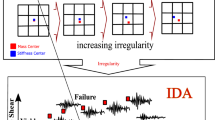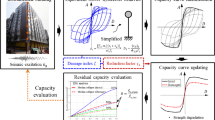Abstract
A framework is proposed to improve seismic performance of special steel moment resisting frame (SMRF) setback structures based on the reliability-based approach. In this procedure, seismic design of midrise setback structures is modified to improve the confidence level of meeting the life safety performance level in these structures to a reliable level. To achieve this, based on the results of the incremental dynamic analysis, an algorithm is proposed to introduce more accurate equations to predict the maximum inelastic inter-story drift ratio of setback structures in linear force-based design methods. It is observed that by applying the proposed relations in the seismic design of setback buildings, this type of structures demonstrates more reliable seismic performance compared to the code-designed approach. The proposed method is economically effective in reducing the possible losses during the lifetime of SMRF setback buildings located in seismic prone areas.












Similar content being viewed by others
References
Cornell, C. A., Jalayer, F., Hamburger, R. O., & Foutch, D. A. (2002). The probabilistic basis for the 2000 SAC FEMA steel moment frame guidelines. Journal of Structural Engineering, 128(4), 526–534.
Crowley, H., Silva, V., Bal, I. E., & Pinho, R. (2012). Calibration of seismic design codes using loss estimation. In 15th World conference on earthquake engineering (15WCEE), Lisbon, Portugal.
Duan, X. N., & Chandler, A. M. (1995). Seismic torsional response and design procedures for a class of setback frame buildings. Earthquake Engineering and Structural Dynamics, 24(5), 761–777.
Federal Emergency Management Agency (FEMA) (2000a). Recommended seismic design criteria for new steel moment-frame buildings. FEMA 350, Washington, DC.
Federal Emergency Management Agency (FEMA) (2000b). Recommended seismic evaluation and upgrade criteria for existing welded steel moment-frame buildings. FEMA 351, Washington, DC.
Federal Emergency Management Agency (FEMA) (2000c). State of the art report on connection performance. FEMA 355D, Washington, DC.
Fragiadakis, M., Vamvatsikos, D., & Papadrakakis, M. (2006). Evaluation of the influence of vertical irregularities on the seismic performance of a nine-story steel frame. Earthquake Engineering and Structural Dynamics, 35(12), 1489–1509.
Habibi, A. R., & Asadi, K. (2014). Seismic performance of reinforced concrete moment resisting frames with setback based on Iranian seismic code. International Journal of Civil Engineering, 12(1), 41–54.
Iranian Seismic Code. (2010). Iranian code of practice for seismic resistant design of buildings (3rd ed.). Standard No. 2800-05. Iran: Building and Housing Research Center (BHRC).
Jalayer, F., & Cornell, C. A. (2003). A technical framework for probability-based demand and capacity factor design (DCFD) seismic formats. PEER Report No. 2003/08, Pacific Earthquake Engineering Center, Berkeley, CA.
Jones, P., & Zareian, F. (2010). Relative safety of high-rise and low-rise steel moment-resisting frames in Los Angeles. The Structural Design of Tall and Special Building, 19(1–2), 183–196.
Karavasilis, T. L., Bazeos, N., & Beskos, D. E. (2008). Seismic response of plane steel MRF with setbacks: Estimation of inelastic deformation demands. Journal of Constructional Steel Research, 64(6), 644–654.
Le-Trung, K., Lee, K., Lee, J., & Lee, D. H. (2012). Evaluation of seismic behavior of steel special moment frame buildings with vertical irregularities. The Structural Design of Tall and Special Building, 21(3), 215–232.
Pirizadeh, M., & Shakib, H. (2013). Probabilistic seismic performance evaluation of non-geometric vertically irregular steel buildings. Journal of Constructional Steel Research, 82(1), 88–98.
Shahrooz, B. M., & Moehle, J. P. (1990). Seismic response and design of setback buildings. Journal of Structural Engineering, 116(5), 1423–1439.
Shakib, H., & Pirizadeh, M. (2014). Probabilistic seismic performance assessment of setback buildings under bidirectional excitation. Journal of Structural Engineering, 140(2), 140–145.
Shakib, H., Pirizadeh, M., Emadi, A., & Shakib, S. (2010). Architectural effects on the seismic behavior of Tehran tall buildings. PEER Rep. No. 2011/07, Proceedings of US-Iran-Turkey seismic workshop, Istanbul, Turkey.
Tehran Comprehensive Plan (TCP). (2007). Tehran Comprehensive Plan. Tehran, Iran: Urban Development and Architectural High Council.
Tena-Colunga, A. (2004). Evaluation of the seismic response of slender, setback RC moment-resisting frame buildings designed according to the seismic guidelines of a modern seismic code. In: 13th world conference on earthquake engineering (13WCEE), Vancouver, Canada.
UBC. (1997). Structural engineering design provisions. Uniform building code, Vol. 2, Whittier, CA: International Conference of Building Officials (ICBO).
Vamvatsikos, D., & Cornell, C. A. (2002). Incremental dynamic analysis. Earthquake Engineering and Structural Dynamics, 31(3), 491–514.
Yun, S., Hamburger, R. O., Cornell, C. A., & Foutch, D. A. (2002). Seismic performance evaluation for steel moment frames. Journal of Structural Engineering, 128(4), 534–545.
Author information
Authors and Affiliations
Corresponding author
Rights and permissions
About this article
Cite this article
Pirizadeh, M., Shakib, H. On a Reliability-Based Method to Improve the Seismic Performance of Midrise Steel Moment Resisting Frame Setback Buildings. Int J Steel Struct 19, 58–70 (2019). https://doi.org/10.1007/s13296-018-0086-y
Received:
Accepted:
Published:
Issue Date:
DOI: https://doi.org/10.1007/s13296-018-0086-y




